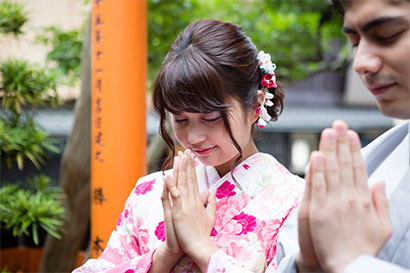
In Japan, people visit shrines or temples at the start of the new year. There they give thanks for the old year passing safely, and hope for good fortune for the new. Most people visit between late-night New Year's Eve and January 3rd. During this period, shrine and temple grounds are filled with people. Experience a Japanese New Year at a shrine or temple yourself!
NEW YEAR CUSTOMS
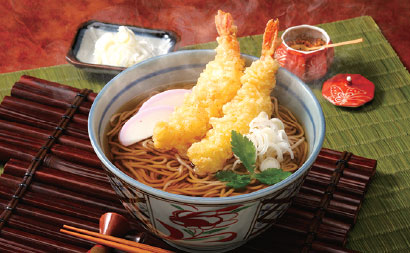
1
New Year's Noodles(Toshi-koshi Soba)
It's traditional to eat soba noodles on New Year's Eve. They are generally eaten listening to the 108 bells that ring out before the new year begins, but you can have them for lunch or dinner instead if you prefer. The long noodles represent the wish to live a long life.
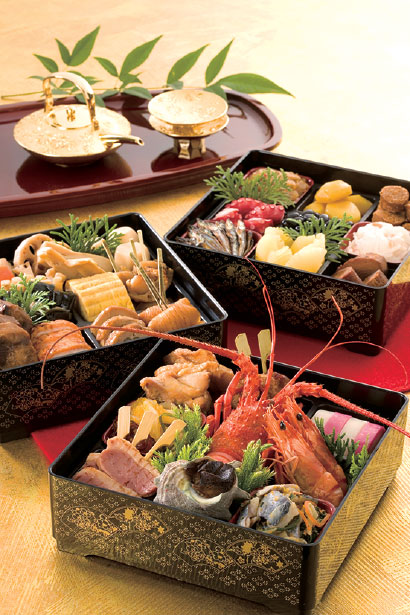
3
New Year's Food (O-Sechi Ryori)
In Japan, specially-prepared food, known as o-sechi, is eaten for the first three days of the year. It includes cooked vegetables, grilled fish, and numerous other delicacies. Each food has a symbolic meaning, such as the many eggs in roe being a hope for many descendants. These days, more and more households get their o-sechi from department stores or supermarkets.
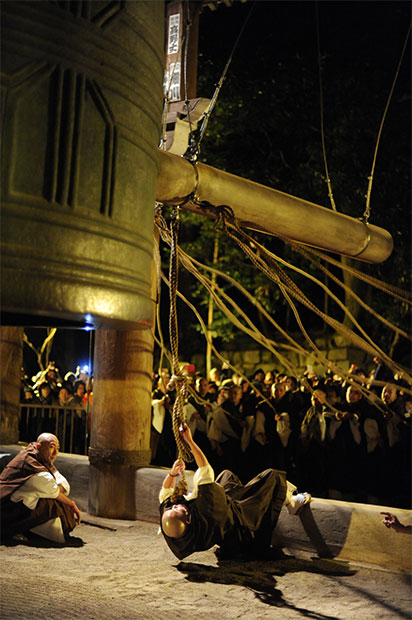
2
Bell-ringing (Joya-no-Kane)
Temples throughout Japan start ringing their bells before midnight on New
Year's
Eve, ringing in the new year. Some temples allow visitors to take turns
striking
the bell. Listen hard and you'll hear bells being rung from all
directions.
*Chion-in: Get off at Gion-Shijo Station (KH39)
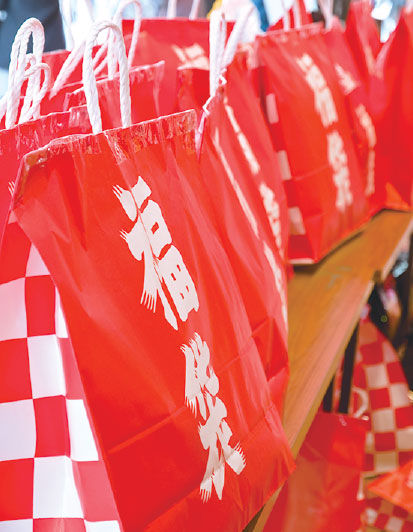
4
Lucky Bags (Fukubukuro)
Department stores and other places sell these, marking the start of business for the new year. The bags contain a number of different items and, while in most cases the buyer can't see what is inside them, they make for considerable bargains. Seeing if there's anything in there that you really wanted is a way to tell how lucky you will be that year.
-

1
Toshi-koshi Soba (New Year's Noodles)
It's traditional to eat soba noodles on New Year's Eve. They are generally eaten listening to the 108 bells that ring out before the new year begins, but you can have them for lunch or dinner instead if you prefer. The long noodles represent the wish to live a long life.
-

2
Bell-ringing (Joya-no-Kane)
Temples throughout Japan start ringing their bells before midnight on New Year's Eve, ringing in the new year. Some temples allow visitors to take turns striking the bell. Listen hard and you'll hear bells being rung from all directions.
*Chion-in: Get off at Gion-Shijo Station (KH39) -

3
New Year's Food (O-Sechi Ryori)
In Japan, specially-prepared food, known as o-sechi, is eaten for the first three days of the year. It includes cooked vegetables, grilled fish, and numerous other delicacies. Each food has a symbolic meaning, such as the many eggs in roe being a prayer for many descendants. These days, more and more households get their o-sechi from department stores or supermarkets.
-

4
Lucky Bags (Fukubukuro)
Department stores and other places sell these, marking the start of business for the new year. The bags contain a number of different items and, while in most cases the buyer can't see what is inside them, they make for considerable bargains. Seeing if there's anything in there that you really wanted is a way to tell how lucky you will be that year.
Most Visited Shrines and Temples
Osaka
-
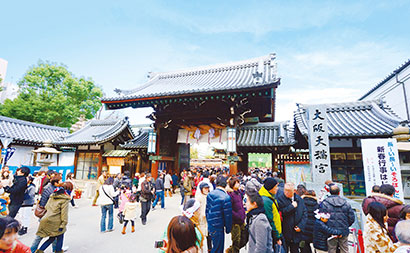
1
Osaka Tenmangu Shrine
BlessingScholarship and virtue, household safety, etc.
This shrine is popularly known as "Tenma Tenjin-san".
+81-(0)6-6353-0025
A 10 minute walk northeast from Naniwabashi Station /
A 15 minute walk northwest from Temmabashi Station -
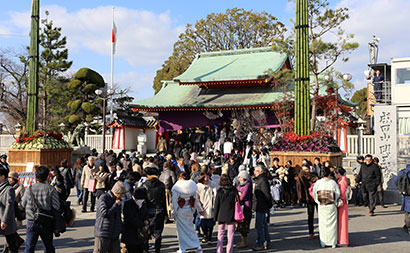
2
Naritasan Fudoson Temple
BlessingTraffic safety, good fortune, warding off evil, etc.
Especially famous as the temple at which to pray for traffic safety. Rising as high as 13 meters and the tallest in Japan, the Good Fortune New Year Kadomatsu decorations welcome visitors.
+81-(0)72-833-8881
A 15 minute walk southeast from Korien Station or right by
the Naritasan Fudoson Mae bus stop.
Keihan buses run all night on New Year's Eve.
Kyoto
-
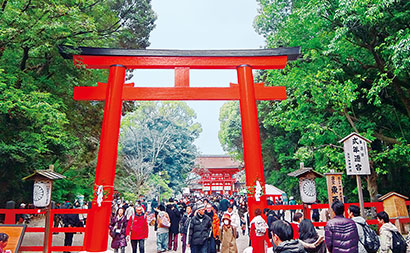
3
Shimogamo-jinja Shrine
BlessingGood fortune, warding off evil, finding a spouse, etc.
One of the oldest shrines in Kyoto, it is registered as a World Cultural Heritage site.
+81-(0)75-781-0010
A 10 minute walk north from Demachiyanagi Station
-
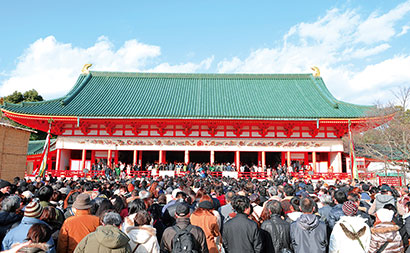
4
Heian-jingu Shrine
BlessingGood luck, avoiding misfortune, household safety, etc.
Built in 1895 to commemorate the 1100th anniversary of Kyoto.
+81-(0)75-761-0221
A 15 minute walk east from Jingu-marutamachi Station /
A 10 minute walk north from Higashiyama Subway Station -
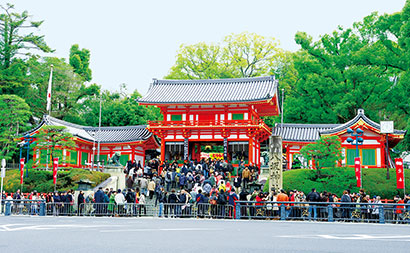
5
Yasaka-jinja Shrine
BlessingGood luck, avoiding misfortune, etc.
Popularly known as "Gion-san." The shrine's vermilion west tower gate is a beautiful sight.
+81-(0)75-561-6155
A 5 minute walk east from Gion-shijo Station
-
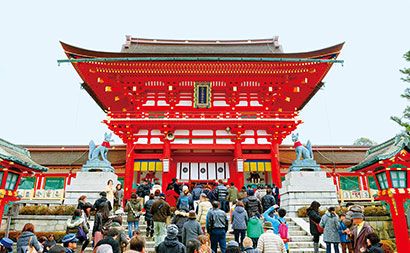
6
Fushimi-inari Taisha Shrine
BlessingBusiness prosperity, household safety, etc.
Famed for its thousand torii gates, the shrine is packed with people during the first three days of the new year. Foxes, considered to be messenger animals of the gods, greet visitors beside the tower gate.
+81-(0)75-641-7331
A 5 minute walk southeast from Fushimi-Inari Station
-
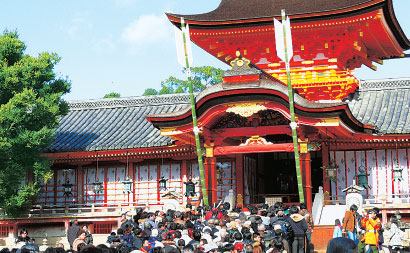
7
Iwashimizu Hachimangu Shrine
BlessingGood luck, avoiding misfortune, fortune in contests, etc.
An old shrine, originally founded in 859, it is considered one of the Three Great Hachiman Shrines of Japan. It was registered as a National Treasure in February 2016.
+81-(0)75-981-3001
A 5 minute walk south from Cable-hachimangu-sanjo Station at the top of the Iwashimizu-hachimangu-sando-cable Line, accessed from Cable-hachimangu-guchi Station
Iwashimizu-hachimangu-sando-cable runs all night on New Year's Eve.